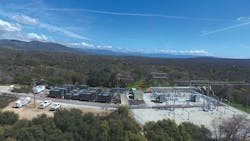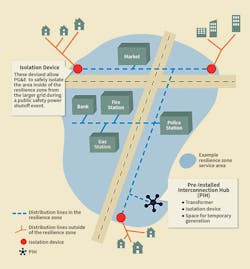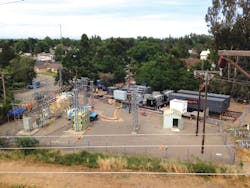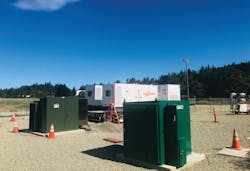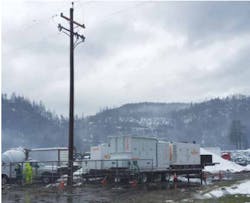Temporary Power Solutions Reduce Outages
In 2013, Pacific Gas and Electric Co. began exploring ways to reduce customer impact during planned and emergency outages. The utility’s primary voltage temporary generation program helped to drive performance toward this priority goal. The program has evolved and expanded in recent years in response to changing environmental conditions, such as increased wildfire threats. In 2012, just 15% of the utility’s service area was designated as having an elevated wildfire risk on the fire-threat maps in effect at that time. As of 2018, approximately 50% of the service area was in high fire-threat areas, due in large part to years of drought resulting in a longer and drier fire season and more extreme weather events.
In response to the dramatically increased wildfire risk, Pacific Gas and Electric (PG&E) implemented a public safety power shutoff (PSPS) program in 2018 as part of its community wildfire safety program. The utility continues to take extensive action to reduce the risk of catastrophic wildfires and minimize the impact of PSPS events on customers. One such course of action has been to expand the use of temporary generation. Mobile, temporary generation can be rapidly deployed to restore power quickly to customers during unplanned outages, avoid planned outages, and reduce the number of customers who experience PSPS events while also mitigating the impacts to those who are affected by them.
In the past, PG&E’s limited use of temporary generation produced mixed results. Objective assessments identified a lack of focused partnerships with vendors and shortages in dedicated operational engineering support, construction, and field expertise as primary areas for improvement. To build on PG&E’s initial experiences, utility leadership tasked a small cross-functional team to overcome these obstacles and build a generation program that could safely and reliably deliver energy to customers when normal distribution or transmission sources become unavailable. While the goal to reduce planned-outage impacts drove the initial development of the temporary primary generation program, the more recent critical need to provide continuity of service during PSPS events resulted in the exponential growth of it.
Short-Term Outages, Long-Term Ramifications
Because T&D systems are not all completely redundant, many utility customers would experience a shutdown in their electric service during system maintenance or emergency repairs if temporary primary generation were not used. Ultimately, shutdowns impact reliability and customer satisfaction.
At many utilities, including PG&E, single — often radial — sources supply customers at a transmission, substation and distribution circuit level without year-round redundant capability. When planned or unplanned maintenance and repairs are required on these sources, utilities must either shut down power to customers or bring generation on-line. This is even more likely in rural service areas, where redundant infrastructure is often more limited.
PSPS events — the planned deenergization of T&D infrastructure — are designed to prevent utility-caused ignitions during extreme weather and ground conditions that escalate wildfire risk. In some cases, permanent interconnection points have been made to enable plug-and-play deployment of mobile generation units with permanently installed step-up transformers and protective devices.
With PSPS events, the scope of equipment being deenergized goes above and beyond any contingencies previously considered and planned by utilities to keep customers’ lights on. Temporary primary generation enables PG&E to keep critical infrastructure energized within lower fire risk areas when normal power sources traveling through higher risk areas are deenergized.
Evaluate the Options
PG&E evaluates the cost, benefit and safety-related risks of every viable solution before making a selection. Often, temporary primary generation is the safest, fastest and most economical approach to keeping the lights on when grid power is not available.
There are two alternatives to temporary primary generation:
- Keep customers deenergized for a potentially lengthy period.
- Shoo-fly the line, where crews erect a temporary electric line to bridge power between two different circuits.
Sometimes a shoo-fly is the best option. Other times it can be more expensive, take too much time, add additional safety hazards to a project, or be impractical because of the terrain, geography or distance between circuits.
Deploy Mobile Primary Generation
In 2015, PG&E partnered with Aggreko plc as a primary generation partner to change how the utility looked at its use of mobile generation. In the past, it tried to set up mobile temporary generators at distribution-level voltages but had limited success for a few reasons.
When an application arose that was a good fit for primary generation, PG&E would source generators, transformers and electrical contractors from multiple vendors, which created complications. Often, the utility’s crews were able to restore power before the primary generators were installed. In the worst cases, the primary generator solutions failed or created a failure within the distribution system. Basically, this initial approach was too slow, produced inconsistent results and lacked the single-point technical expertise of a single temporary solutions provider.
PG&E challenged Aggreko to design a single trailer for housing all needed equipment to interconnect easily with the utility’s distribution system. Less than a year later, the supplier, in consultation with PG&E, designed and assembled the PowerPak — a single trailer that produces 12-kV power, includes medium-voltage electrical protective devices, has load-break bushings for interconnection into the grid and can power up to 300 homes.
With the success of the PowerPak in 2015, PG&E looked to expand the newly budding primary generation program to megawatt-sized projects that could be built adjacent to or inside substations and power several thousand homes. A cross-functional team focused on a single target project with Aggreko to prove out the use of primary generation, delivering 7 MW of generators, transformers and switchgear to provide power at 12 kV to the Rice substation in June 2015.
As of spring 2020, PG&E had secured just over 450 MW of temporary generation for use in medium-voltage applications to mitigate the public impact of PSPS events. These megawatts will be used across four different workstreams: mid-feeder microgrids, substation-sited microgrids, community resource centers (CRCs) and individual customer backup power support.
Overcome Challenges
Initially, the team reported early growing pains. PG&E was new to putting temporary generators on the grid and its chosen partner was new to the utility’s policies and procedures. Challenges were overcome through close collaboration between the electrical engineering departments of both companies and the businesspeople leading the projects. Acting as partners in the best interests of the program, both companies learned and grew together, and the primary generation program has since thrived.
In the initial stages of program implementation, necessary medium-voltage equipment — including switchgear, cable, protection breakers and transformers — were not always readily available. Identifying and securing the equipment in advance helped to avoid potential pitfalls associated with accelerated project execution and missed deadlines.
Another important insight: Electrical engineers from both companies worked together to establish protection settings that met the utility’s policy and procedures for frequency and voltage parameters but also provided enough flexibility for the generator to run through large, sudden load swings without nuisance tripping.
The safety of personnel operating these grids and public exposure are always the foremost factors in designing the sites. With crew safety being the top priority, one of the most critical considerations is the choice of system grounding. At PG&E, most of the distribution primary is three-wire construction, meaning there is not a neutral system running within the distribution feeders. Therefore, these temporary primary generation projects require the construction of a temporary grounding grid that can provide a fault return path while reducing the potential step and touch hazards that could exist either during fault or normal operating conditions.
Other challenges were as follows:
- Protection sensitivity on distribution lines when using temporary generators, as they are weaker generation sources vs. the grid
- Sourcing of mobile step-up transformers with appropriate configuration to provide grounded sources
- Development of appropriate frequency and voltage settings that provide reliable power while adequately protecting the system and customers during islanded conditions
- Generator control system standardization, with variations between systems and vendors
- In-rush, cold load pickup and other transient constraints when on temporary generation
- Dealing with a leading power factor (that is, a capacitive load condition) on distribution circuits when using islanded generators with very limited capability in powering capacitive loads (volt-ampere-reactive absorbing capability is limited)
- Control center operations personnel familiarity with testing, synchronizing and running temporary generation islands.
Another challenge tackled by this partnership revolved around the need for a single generator, transformer and protective device package that could be mounted on one tractor trailer. The two-company team developed a 500-kW, 12-kV solution that met these requirements. The back of the trailer featured easy-to-access load break elbows that were tied into temporary medium-voltage cables with minimal effort, substantially decreasing deployment and setup time.
The utility primary generation activities at PG&E have evolved over the past several years. With safety in mind, the utility originally started out with a simple strategy of “break before make” when interconnecting temporary generators to islanded loads between 100 kW and 4 MW, which required a brief outage to connect and disconnect the generators.
Aggreko introduced the idea of synchronizing its generators to the grid to provide a seamless transfer of the customer load from the grid to the generators at the start of the utility’s clearance. By doing so, the customer impact was reduced because no outage was required at the beginning of the event to transfer customers over to generator power; however, an outage was still required at the completion of the clearance to return the customers to utility power.
After some time, Aggreko identified the opportunity to re-parallel the temporary generation island back into the normal utility source at the completion of the clearance, which required custom-designed switchgear. The utility and vendor partner teams collaborated on, and Aggreko built, mobile synchronizing switchgear, which is a simple design using standard utility relays that can be deployed to various sites as needed. This switchgear also functions as the primary protective circuit breaker for line protection while in the island configuration. In addition to improving load transfer between the generators and grid, the utility has been able to scale this solution from a single generator supplying 500 kW of power to entire substations serving 30 MW to 50 MW of customer load.
Many of the challenges were solved by assigning to these projects dedicated engineering and construction personnel who have an excellent fundamental understanding of the electrical and mechanical aspects of distribution line, substations and power generation apparatuses.
Crucial to the success of the program, electrical engineering studies that model short circuits and power flow to ensure voltage, loading and protection considerations were accounted for during deployment at each temporary generation site. In addition, when dealing with unpredictable volt-ampere-reactive (VAR) flow from capacitor bank switching, inductive load banks were brought in to help stabilize VAR flow.
Consistent Gains and Benefits
The initial project proved mobile primary generation could be deployed by PG&E as a safe and effective alternative that can eliminate the need for deenergization of customers under certain operating events. The new strategy reduced PG&E’s customer impact, saving more than 11 million customer outage minutes in the first year. The number of customer outage minutes deferred has increased significantly year over year since the program’s inception.
Traditionally, the deployment of capital and noncapital projects that would improve the reliability of the grid has been limited by how long a utility can remove customers from power. By using temporary primary generation, PG&E learned it can accelerate deployment of these projects and its reliability performance without the negative impacts and restrictions associated with keeping customers deenergized.
Following are additional benefits of temporary generation:
- Quicker times of restoration for certain unplanned outages
- Eliminating the need for planned outages when maintenance requires lines to be deenergized
- Improving overall reliability of electric service to customersImproving customer average interruption duration index, system average interruption duration index and system average interruption frequency index, which can increase the success of rate cases with public utility commissions
- Alleviating overloaded T&D equipment during heat events, thereby avoiding unplanned outages
- Accelerating deployment of reliability-improving projects (capital and noncapital).
PG&E’s future deployments will benefit from these lessons learned:
- Grounding is critical. Proper grounding cannot be measured arbitrarily by how many ground rods are driven. The only way to ensure a primary generation project is properly grounded is to perform a resistance test. PG&E strives to achieve 1.5 ohm on temporary ground grids and no more than 5 ohm if ground conditions prevent anything better.
- All medium-voltage cable should be Megger tested at the job site prior to terminating onto rental equipment.
- External spill containment should be used on any equipment containing fluids (for example, generators, transformers and fuel tanks).
- End-of-line fault studies should be performed for every primary generation project to ensure temporary generators produce enough fault duty to enable existing and temporary protection equipment to function properly.
- Back-feed power sources (like backup generators, wind power and solar power) and capacitor banks should be evaluated carefully in detailed power flow modeling when energized by temporary generators.
- Factors like the potential for leading power factor, an unbalanced three-phase load, a recloser strategy, and an electrical protection strategy and coordination should all be reviewed closely as part of the planning phase of any primary generation project.
- Electrical protection settings like undervoltage and overvoltage as well as under-frequency and over-frequency need to be mutually agreed upon to avoid nuisance tripping the temporary generation while still meeting the utility’s guidelines for these parameters.
Now, PG&E is looking to expand its technical capabilities in this space with the integration of battery energy storage systems using natural gas and diesel generation units to help reduce the size and improve transient load capability of the deployments. The utility also has used renewable diesel on projects successfully to help minimize environmental impacts associated with these deployments.
James Tuccillo ([email protected]), P.E., distribution operations engineering, PG&E, has 10 years of utility power engineering and leadership experience at PG&E including control center operations, real-time operations engineering, distribution planning, and primary voltage generation interconnections. James is a recognized subject matter expert on distribution network modeling and system analysis within both planning and operational applications. He has a BS and MS degree in Electrical Engineering from California Polytechnic State University and is a registered Professional Engineer in California.
Branden Ezell ([email protected]) principal supervisor, temporary grid solutions, PG&E, has 10 years of experience with PG&E holding several roles in electric operations leadership including Control Center Supervisor, Distribution M&C Supervisor and Transmission Line Supervisor. Prior to joining PG&E Branden was an interior wireman and, a U.S. Navy veteran, was responsible for advanced based power distribution systems during his multiple deployments.
Frank Pizzileo ([email protected]) manager, utility sector – West, Aggreko , is a leader in temporary power, heating and cooling. With Aggreko since 2013, he has over 25 years of experience in the energy industry encompassing both traditional power generation and renewable energy. He holds a Bachelor of Science degree in Mechanical Engineering from New York Institute of Technology and was recently accepted into Saint Mary’s College of California’s MBA program.
About the Author
James Tuccillo
James Tuccillo, P.E., Distribution Operations Engineering, PG&E ([email protected]), has 10 years of utility power engineering and leadership experience at PG&E including control center operations, real-time operations engineering, distribution planning, and primary voltage generation interconnections. James is a recognized subject matter expert on distribution network modeling and system analysis within both planning and operational applications. He has a BS and MS degree in Electrical Engineering from California Polytechnic State University and is a registered Professional Engineer in California.
Branden Ezell
Branden Ezell, Principal Supervisor, Temporary Grid Solutions, PG&E ([email protected]) has 10 years of experience with PG&E holding several roles in electric operations leadership including Control Center Supervisor, Distribution M&C Supervisor and Transmission Line Supervisor. Prior to joining PG&E Branden was an interior wireman and, a U.S. Navy veteran, was responsible for advanced based power distribution systems during his multiple deployments.
Frank Pizzileo
Frank Pizzileo, Manager, Utility Sector – West, Aggreko ([email protected]), is a leader in temporary power, heating and cooling. With Aggreko since 2013, he has over eighteen years of experience in the energy industry encompassing both traditional power generation and renewable energy. He holds a Bachelor of Science degree in Mechanical Engineering from New York Institute of Technology and was recently accepted into Saint Mary’s College of California’s MBA program.
